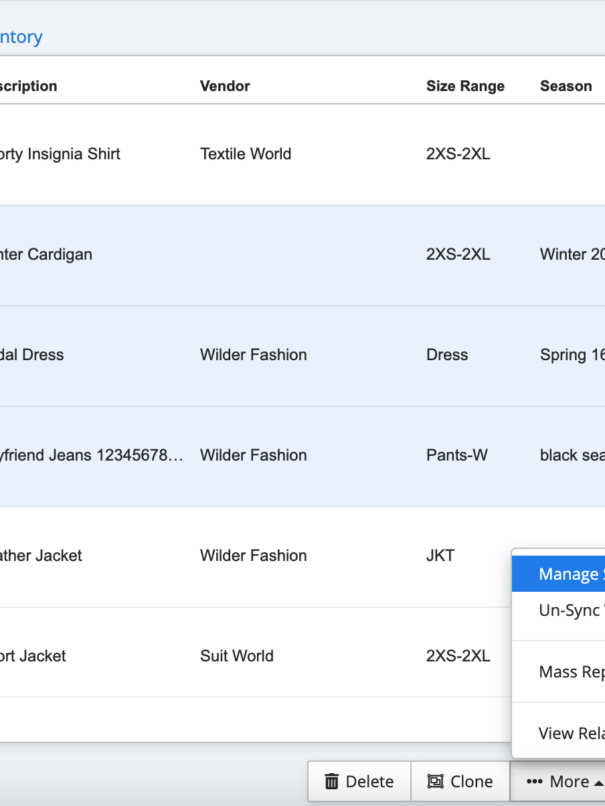Enterprise resource planning (ERP) and customer relationship management (CRM) are often the two main software options that apparel companies choose when attempting to automate essential business processes.
CRM helps companies manage how customers interact with their businesses, while ERP connects financial and operational systems to a single database to help businesses run successfully.
Both these systems are essential for data storage and organization and both of them cover several departments. But although they occasionally share a platform, each software is usually purchased independently and integrated as required.
In this post, we’re explaining in more detail what ERP and CRP systems are, how they differ, and how you can integrate them to maximize the efficiency of your apparel business.
What are ERP and CRM Systems?
Both ERP and CRM systems are effective business solutions that can boost your productivity and your bottom line. But while there are numerous similarities between them, their main functionalities differ. Let’s contrast and compare to see how each of them can help your fashion business:
What Is CRM?
CRM software is made to assist companies in managing data about customer interactions. CRM systems can produce sales forecasts, guide prospects through the sales process, manage invoices, and coordinate communications.
A few of the key CRM features include automation and management of marketing campaigns, analysis of consumer behavior, high-quality customer care, automation of repetitive tasks, identifying new leads, and streamlining the sales process.
A CRM can help boost productivity, increase sales, provide accurate customer data, increase customer satisfaction and interaction levels, and improve customer service quality.
What Is ERP?
While a CRM is made to help apparel companies manage their relationship with customers, an ERP system is designed to manage the entire business cycle, including customers.
ERP is a system designed to increase the effectiveness of all corporate activities by automating and minimizing manual tasks. The ERP system receives data from users, which generates real-time information that is accessible to the entire organization.
Some of the most important features you can use with an ERP system include entering business process information in real-time, tracking supply chains and manufacturing, creating company-wide strategies, managing payroll, employee information, and benefits, etc.
The Difference Between ERP and CRM
As mentioned earlier, both ERP and CRM can help streamline business processes through automation. While an ERP system is involved in back-end process management, a CRM system primarily manages the front end of the company. The majority of ERP systems will have at least some CRM components, so it’s safe to say that CRM is a subset of ERP.
ERP’s primary goal is to boost productivity by streamlining business procedures for all organizational departments, whereas CRM’s main purpose is to enhance customer interactions and client retention. Additionally, CRM concentrates on boosting sales while ERP is focused on enhancing the precision and efficacy of the entire system.
Workflow management, inventory, scheduling, POs, invoicing, and other capabilities are among an ERP’s key components. Because of this, ERP is used to streamline and expedite internal organizational tasks including project planning, finance, and order management. CRM, on the other hand, focuses more on managing and nurturing contacts and leads, marketing automation, social network integrations, etc., which makes it a perfect solution for the sales, marketing, and customer service departments.
Image by Freepik
ERP and CRM Integration
Fashion businesses that are looking to expand and grow often wonder which of these two systems to implement first. Because both ERP and CRM have particular advantages, choosing between them can be challenging.
CRM has a lot to offer and may significantly contribute to the growth of your apparel company. However, the fact remains that it is just another type of software program that only performs one function. The concern is whether or not the tool can successfully integrate into the system you are currently using or whether it will be compatible if you decide to alter those systems in the future. There is also the argument that purchasing a CRM separately will cost you more money than purchasing a software package that includes all the capabilities you require to make your business profitable.
The good news is that the integration of CRM and ERP software will strengthen the best aspects of both systems, helping to automate and speed up customer interactions and providing better visibility across all phases of the business process. Despite the fact that they each perform their own thing differently, there is overlap, making it worthwhile to invest the extra money in ERP and CRM integration.
Below are some of the key benefits of integrating ERP and CRM systems:
1. Data centralization
Customer relationship management software and enterprise resource software both store extensive customer-related data, including contact details, order history, as well as shipping and billing details. By integrating these two systems, you’ll be able to see all the details in one place instead of having to look for the same account in two different software solutions. In addition, data entry will also be much easier and faster.
2. Improved collaboration
The key advantage of both CRM and ERP is the ability to collaborate across different departments in the organization without siloes. In a siloed business model, departments are fully isolated from one another which discourages collaboration, makes data access difficult, and data duplication common. A cross-departmental strategy guarantees that accurate, real-time data is always used and that departments are cooperating to achieve the same objectives.
3. Reduced data duplication
Duplicate data may be a huge pain for software users, as anyone who has used an automated solution like CRM or ERP before would attest. Luckily, duplicate data entry will become a thing of the past with an integrated strategy because CRM in ERP follows the same guidelines and structures.
4. Better forecasting
Sales representatives at large fashion companies must have access to data stored in the ERP system. They frequently have to check the status of an order, make modifications, and monitor the development of orders and accounts at any moment, among other things.
With ERP and CRM integration, forecasts and customer demand can be matched much more easily. This will enable you to improve delivery times, plan around consumer trends, avoid excess inventory or stockouts, and ultimately increase the level of customer satisfaction.
5. Time savings
When your enterprise resource planning system and customer relationship management software are integrated, sales representatives will be able to take a proposal from the CRM system and convert it immediately into an order in the ERP software without having to switch between systems or entering the same information several times. This will save lots of time and increase your team’s efficiency. In addition, your team members will have easier access to make changes if necessary and enhanced visibility into the status of an order.
6. Improved customer service and experience
Thanks to the complete visibility that linked ERP and CRM enable, you’ll be able to provide your customer with the clothes they need, when they need them, on the sales channels they prefer.
Moreover, employees across your company can collaborate seamlessly to assist customers when they can view the complete customer picture—call history, orders, preferences, support queries, contracts, and other info—in real time, leading to improved customer service and outstanding customer experience.
The Bottom Line
The integration of enterprise resource planning software and customer relationship management software ensures an automated and consistent information flow across both systems to establish a single source of truth. It synchronizes both systems into a single, unified database. This helps convert website visitors into leads, leads into paying customers, and customers into loyal shoppers in less time!
ApparelMagic powers CRM, ERP, and PLM for some of the biggest names in fashion. Since it is easy to use and affordable, it is the ideal apparel management software solution for growth!







